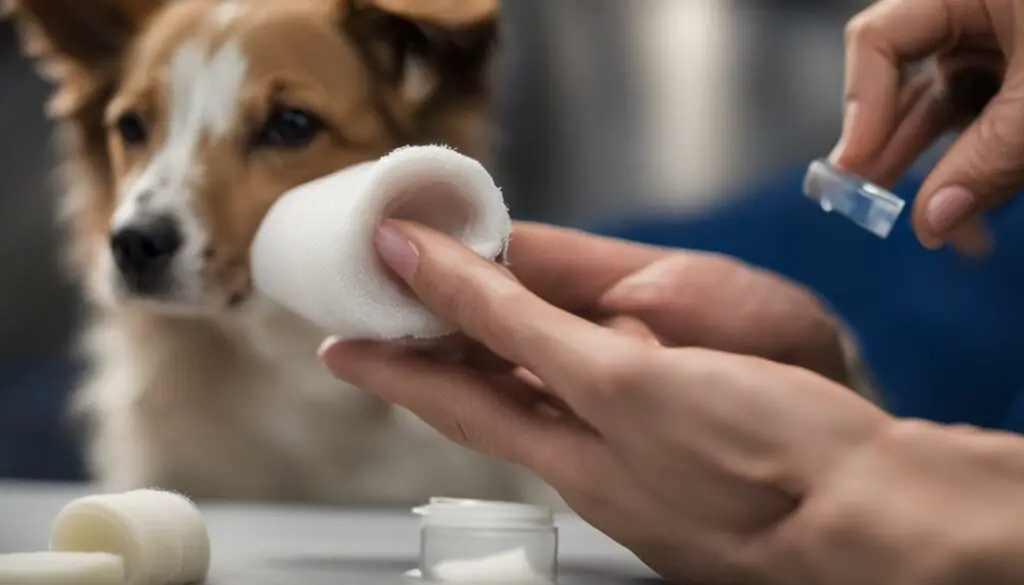As a dog owner, you may be wondering if you can use liquid bandage to treat your furry friend’s wounds. The good news is that liquid bandages can indeed be used on dogs as a form of wound treatment. However, there are a few important considerations to keep in mind to ensure the safety and effectiveness of using liquid bandage on dogs.
Firstly, it’s essential to assess the type and severity of the wound. Liquid bandages are best suited for small, clean, and dry cuts in areas that tend to reopen due to body movement, such as the ears, nails, nose, or paws. These areas are prone to infection and can benefit from the protective barrier created by the liquid bandage. However, it’s important to note that liquid bandages should not be used on wounds that are leaking discharge or deep wounds that may require medical attention.
When choosing a liquid bandage for your dog, it’s recommended to opt for trusted brands and products formulated specifically for pets. These brands often contain fewer irritants and harsh chemicals, promoting faster healing and reducing the risk of skin reactions. Additionally, consider the application method, such as spray or foam, and choose the option that is easiest to use and apply on your dog’s wound.
Proper application of liquid bandage is crucial to its effectiveness. It’s important to follow the instructions provided by the manufacturer and ensure that the bandage adheres properly to the wound. To prevent dogs from licking the bandage, which can interfere with the healing process, consider using a cone or alternative options such as inflatable collars or soft cones.
Key Takeaways:
- Liquid bandages can be used on dogs for wound treatment, but it’s important to consider the type and severity of the wound.
- Choose liquid bandages formulated specifically for pets to reduce the risk of skin reactions and promote faster healing.
- Proper application is crucial for the effectiveness of liquid bandages on dogs‘ wounds.
- Consider using a cone or alternative options to prevent dogs from licking the bandage.
- Consult with a veterinarian for specific advice and guidance based on your dog’s individual needs.
Liquid Bandages for Dogs: A Pet-Friendly Alternative to Standard Bandages
When it comes to wound treatment for dogs, liquid bandages offer a pet-friendly alternative to traditional bandages. Liquid bandages have become increasingly popular among pet owners due to their ease of use and effectiveness in promoting healing. Unlike standard bandages, which can often be cumbersome and prone to coming off, liquid bandages provide a convenient and flexible solution for covering and protecting wounds.
One of the main benefits of using liquid bandages on dogs is their ability to create a seal over the wound, preventing bacteria from entering and reducing the risk of infection. This is especially important in areas that are prone to constant movement, such as the ears, nails, nose, or paws. Liquid bandages also dry quickly, forming a protective barrier that helps to minimize discomfort and further injury.
Another advantage of liquid bandages is that they are formulated to be more pet-friendly. They contain fewer harsh chemicals and irritants compared to human bandages, reducing the chances of skin irritation or adverse reactions in dogs. Pet-specific liquid bandages often include ingredients such as aloe and chamomile, which help soothe the skin and alleviate itching.
Table: Liquid Bandages vs. Standard Bandages – A Comparison
| Aspect | Liquid Bandages | Standard Bandages |
|---|---|---|
| Convenience | Easy and quick to apply, no need for wrapping or securing | Require wrapping, tying, or adhesive for proper application |
| Flexibility | Flexible and conform to the contours of the wound and body part | Rigid and may restrict movement in certain areas |
| Protection | Create a seal over the wound, preventing bacteria from entering | Provide a physical barrier but may not fully seal the wound |
| Skin Irritation | Formulated to be less irritating, with pet-friendly ingredients | May contain more harsh chemicals, increasing the risk of irritation |
Using liquid bandages on dogs can be a game-changer for pet owners seeking a reliable and effective way to treat wounds. They offer a pet-friendly alternative to standard bandages, with the added benefits of convenience, flexibility, and reduced risk of skin irritation. However, it’s important to note that liquid bandages are best suited for small, clean, and dry cuts that are prone to reopening. For more severe or infected wounds, it’s crucial to seek veterinary attention.
In conclusion, liquid bandages provide a pet-friendly solution for wound treatment in dogs. They offer numerous benefits, such as promoting healing, preventing infection, and reducing the risk of further injury. However, it’s essential to choose the right product and follow proper application techniques. Additionally, it’s important to monitor the wound and consult a veterinarian if there are any signs of infection or if the wound worsens. By incorporating liquid bandages into your pet’s first aid kit, you can provide effective and efficient wound care for your furry friend.
Choosing the Right Liquid Bandage for Your Dog
When it comes to choosing a liquid bandage for your dog, it’s important to consider the specific needs of your furry friend. There are various options available in the market, ranging from pet-specific brands to trusted brands that offer liquid bandages suitable for dogs.
If you prefer pet-specific brands, these are specially formulated to be non-toxic and more pet-friendly. They often contain additional ingredients like aloe and chamomile, which can help soothe your dog’s skin and reduce itching. These brands have established a financial and social history, providing reassurance of quality and safety.
On the other hand, if you prefer trusted brands that are not pet-specific, it’s important to choose products that have a proven track record of effectiveness and safety. These brands may have been used by pet owners in the past and have received positive feedback.
| Brand | Features |
|---|---|
| Remedy+Recovery Liquid Bandage For Dogs | Aloe and chamomile ingredients to soothe and reduce itching |
| Vet Aid Sea Salt Wound Care Foam | Made from natural sea salt and free from harsh chemicals |
Choosing the right liquid bandage depends on your preferences and your dog’s specific needs. It’s also important to consider the application method, such as spray or foam, to ensure ease of use and application on your dog’s wound. By selecting the appropriate liquid bandage for your dog, you can provide effective wound care and promote their overall well-being.
Using Human Liquid Bandage on Dogs: What You Need to Know
When it comes to using human liquid bandage on dogs, there are a few important considerations to keep in mind. While it is technically safe to use human formulas on dogs, there is a higher risk of potential skin reactions due to the higher levels of alcohol and other irritants found in these products. It is crucial to closely monitor your dog for any signs of skin irritation or rashes after applying a human liquid bandage.
Additionally, one of the main challenges is preventing dogs from licking the liquid bandage. Dogs often have a natural instinct to lick their wounds, which can interfere with the healing process and potentially lead to ingesting toxic chemicals. It is essential to take precautions to prevent this, such as using a cone or alternative methods to restrict access to the bandaged area.
However, to ensure the safety and effectiveness of liquid bandages on dogs, it is highly recommended to choose products specifically designed for pets. These pet-specific liquid bandages are formulated to be non-toxic and more pet-friendly, reducing the risk of skin reactions. By opting for pet-specific brands, you can provide your furry friend with the best possible care and minimize any potential risks.
Overall, while using human liquid bandage may be a viable option for dogs, it is important to proceed with caution and prioritize the safety and well-being of your pet. It is always a good idea to consult with your veterinarian before using any products to ensure they are suitable for your dog’s specific needs.

| Precautions when using human liquid bandage on dogs |
|---|
| Choose pet-specific brands formulated to be non-toxic and pet-friendly. |
| Closely monitor your dog for any signs of skin reactions after applying the bandage. |
| Prevent dogs from licking the bandage by using a cone or alternative methods. |
| Consult with a veterinarian before using any products on your dog. |
When to Use Liquid Bandages on Your Dog’s Wounds
Using liquid bandages on your dog’s wounds can be beneficial for specific types of injuries. These include small, clean, and dry cuts in areas that are prone to reopening due to body movement, such as the ears, nails, nose, or paws. Liquid bandages create a protective barrier over the wound, sealing it and preventing bacteria from entering. This helps reduce the risk of infection and promotes faster healing. However, it’s important to assess the severity of the wound and consider whether medical attention is necessary.
In general, liquid bandages are best suited for minor cuts and wounds that don’t require immediate veterinary intervention. They can be a useful addition to a pet’s first aid kit, providing a temporary solution until medical attention can be obtained if needed. It’s important to monitor the wound closely after applying the liquid bandage and watch for signs of infection or worsening condition. If the wound is deep, leaking discharge, or showing signs of infection, it’s best to consult with a veterinarian for proper evaluation and treatment.
Specific Types of Injuries for Liquid Bandage Use
Liquid bandages are most effective for small, clean, and dry cuts or wounds that are prone to reopening due to body movement. Here are some specific types of injuries where liquid bandages can be beneficial:
- Cuts on the paws from sharp objects or nails
- Scratches on the ears from rough play or encounters with other animals
- Minor abrasions on the nose from rubbing against rough surfaces
- Small wounds on the nails from trimming or accidents
By using liquid bandages on these specific types of injuries, you can help protect your dog’s wounds and promote quicker healing. However, it’s important to remember that every situation is unique, and it’s always best to consult with a veterinarian for personalized advice and guidance.
| Type of Injury | Suitable for Liquid Bandages |
|---|---|
| Small, clean, and dry cuts on the paws | Yes |
| Minor scratches on the ears | Yes |
| Abrasions on the nose | Yes |
| Small wounds on the nails | Yes |
| Deep wounds | No |
| Wounds leaking discharge | No |
Remember to always assess the severity of the wound and consult with a veterinarian if you’re unsure about whether to use a liquid bandage. Your veterinarian can provide guidance based on the specific needs of your dog and ensure proper wound care.
Precautions and Exclusions for Using Liquid Bandages on Dogs
When using liquid bandages on dogs, it is important to take certain precautions and be aware of certain exclusions. While liquid bandages can be a helpful tool in treating wounds, there are specific cases where they should not be used. It is important to understand these precautions and exclusions to ensure the safe and effective use of liquid bandages on dogs.
One precaution to keep in mind is that liquid bandages should not be used on wounds that are leaking any type of discharge. This could indicate an infection that requires medical attention. Additionally, liquid bandages should not be used on hot spots or irritated skin, as these conditions may require specific treatments. Deep wounds should also not be treated with a liquid bandage, as they may require stitches or medical intervention.
Minor cuts and scrapes, which are small wounds that heal faster when exposed to air, should not be covered with a liquid bandage. This is because liquid bandages can trap bacteria inside, potentially leading to infection. It is important to allow these types of wounds to heal naturally without the use of a liquid bandage.
| Precautions for Using Liquid Bandages on Dogs | Exclusions for Using Liquid Bandages |
|---|---|
| Do not use on wounds leaking discharge | Do not use on hot spots or irritated skin |
| Do not use on deep wounds | Do not use on minor cuts and scrapes |
By following these precautions and exclusions, you can ensure the safe and appropriate use of liquid bandages on your dog. It is always advisable to consult with a veterinarian for specific advice and guidance based on your dog’s individual needs.
Recommended Brands and Products for Liquid Bandages for Dogs
When it comes to choosing a liquid bandage for your dog, it’s important to select trusted brands that specialize in pet wound care. These brands offer a range of pet-specific liquid bandages that are formulated to be safe and effective for dogs. Here are some recommended brands and products for liquid bandages:
| Brand | Product |
|---|---|
| Remedy+Recovery | Liquid Bandage For Dogs |
| Vet Aid | Sea Salt Wound Care Foam |
| Stella & Chewy’s | Stella’s Solutions Liquid Bandage |
Remedy+Recovery Liquid Bandage For Dogs is a popular choice among pet owners. It contains aloe and chamomile, which help soothe itching and provide additional comfort for your dog. Vet Aid Sea Salt Wound Care Foam is made from natural sea salt and is free from harsh chemicals, making it a gentle option for your furry friend. Stella & Chewy’s Stella’s Solutions Liquid Bandage is another trusted brand that offers a pet-specific liquid bandage formulated to promote healing and protect wounds.
By choosing these recommended brands, you can have peace of mind knowing that you’re using high-quality liquid bandages specifically designed for dog wound care. Always follow the application instructions provided by the manufacturer to ensure safe and effective use.
Additional Considerations
While these recommended brands offer reliable options, it’s important to consult with your veterinarian for specific advice and guidance based on your dog’s individual needs. Your veterinarian can provide personalized recommendations and assist you in selecting the best liquid bandage for your dog’s specific wound care requirements. They can also provide additional insights and recommendations for proper wound care and prevention of infection.
Using Cones to Prevent Dogs from Licking Wounds
When dogs suffer from wounds or injuries, they often have a natural instinct to lick and chew at the affected area. While this behavior is intended to provide comfort, it can actually hinder the healing process and even lead to further complications. To prevent dogs from licking their wounds, cones, also known as Elizabethan collars or e-collars, are commonly used.
Cones create a physical barrier around the dog’s head, preventing them from reaching the wound with their tongue. This barrier helps to reduce the risk of infection and further injury, allowing the wound to heal properly. Traditional cones, made from rigid plastic, are highly effective in preventing dogs from accessing their wounds. However, some pet owners may find them uncomfortable or restrictive for their dogs.
Fortunately, there are alternative options available for pet owners who want to provide their dogs with a more comfortable experience while still preventing them from licking wounds. Inflatable collars and soft cones are two popular alternatives that offer similar levels of protection while allowing for more freedom of movement. These alternatives are especially beneficial for dogs who may be easily stressed or anxious when wearing traditional cones.
By using cones or alternative options, pet owners can ensure that their dogs’ wounds are protected and given the best chance to heal. It’s essential to choose the right size and type of cone for your dog, ensuring a proper fit that is secure but not overly tight. Additionally, it’s important to monitor your dog’s behavior and the condition of the wound while the cone is being worn, as any signs of discomfort or worsening should be addressed promptly.
| Benefits of Using Cones | Pet Cone Alternatives |
|---|---|
| Prevents dogs from licking wounds | Inflatable collars |
| Reduces the risk of infection | Soft cones |
| Prevents further injury |
The Benefits of Using Liquid Bandage on Dogs
Using liquid bandage on dogs can provide several benefits for their wound care. Liquid bandages promote healing by sealing the wound and creating a barrier against infection-causing bacteria. They also reduce the risk of further injury by keeping the wound closed and protected. Liquid bandages can be especially beneficial for areas prone to reopening due to body movement, such as the ears, nails, nose, or paws. They provide a quick and convenient solution for pet owners to address minor cuts and wounds that may not require veterinary intervention.
One of the key advantages of using liquid bandages on dogs is their ability to prevent infection. When applied properly, liquid bandages create a protective layer over the wound, preventing bacteria and dirt from entering, which can lead to infection. By keeping the wound clean and protected, liquid bandages promote faster healing and reduce the risk of complications.
Another benefit of using liquid bandages is the ability to reduce the risk of further injury. Liquid bandages provide a barrier that keeps the wound closed, protecting it from licking, scratching, or other activities that may reopen the wound. This can be particularly important in areas that are prone to constant movement, such as the paws, where traditional bandages may not stay in place as effectively. By keeping the wound closed and protected, liquid bandages can help accelerate the healing process.
In addition to promoting healing and preventing infection, liquid bandages offer convenience and ease of use for pet owners. Liquid bandages are quick and easy to apply, and they dry quickly, eliminating the need for additional dressings or bandages. This makes them a practical solution for minor cuts and wounds that can be treated at home. However, it’s important to note that liquid bandages should not be used on deep wounds or wounds that are leaking discharge, as these may require medical attention.
Table: Benefits of Using Liquid Bandage on Dogs
| Benefits | Description |
|---|---|
| Promotes Healing | Seals the wound and creates a barrier against infection-causing bacteria, promoting faster healing. |
| Prevents Infection | Creates a protective layer over the wound, preventing bacteria and dirt from entering and reducing the risk of infection. |
| Reduces Risk of Further Injury | Keeps the wound closed and protected, preventing activities that may reopen the wound and accelerating the healing process. |
| Convenient and Easy to Use | Quick and simple application, drying quickly without the need for additional dressings or bandages. |
Overall, using liquid bandages on dogs can be a beneficial addition to their wound care regimen. They provide an effective, pet-friendly alternative to traditional bandages, promoting healing, preventing infection, and reducing the risk of further injury. However, it’s important to use liquid bandages properly and follow any specific instructions or recommendations from a veterinarian. By utilizing liquid bandages as part of a comprehensive wound care approach, pet owners can help ensure the well-being and recovery of their furry companions.
Common Liquid Bandage Options for Dog Wound Care
In dog wound care, there are various types of liquid bandage options available. These options include spray and foam bandages, each offering its own unique benefits and application methods. Spray bandages provide quick and easy coverage, making them convenient for use on smaller wounds. Foam bandages, on the other hand, offer a thicker and more controlled application, making them suitable for larger wounds or areas that require greater precision.
When choosing a liquid bandage for your dog, it’s important to consider the specific needs of the wound and the preferences of your pet. Some liquid bandages are formulated with additional ingredients such as aloe and chamomile, which can help soothe the wound and reduce itching. These ingredients can be particularly beneficial for dogs with sensitive skin or those prone to allergies.
When it comes to choosing between spray and foam bandages, it ultimately depends on the size and location of the wound. For smaller wounds or areas that require quick coverage, a spray bandage may be more suitable. However, for larger wounds or areas that require more control during application, a foam bandage may be a better option.
It’s essential to carefully read and follow the instructions provided by the manufacturer when applying a liquid bandage on your dog. This will ensure that the bandage adheres properly and effectively seals the wound. Additionally, monitoring your dog’s behavior and preventing them from licking the bandage is crucial, as excessive licking can disrupt the healing process.
| Liquid Bandage Option | Application Method | Key Features |
|---|---|---|
| Spray Bandages | Easy and quick application | Convenient for smaller wounds |
| Foam Bandages | Thicker and more controlled application | Suitable for larger wounds or precise application |
| Pet-Specific Formulas | Varies | May contain additional ingredients for soothing and reducing itching |
Tips for Applying Liquid Bandage on Dogs
Proper application of liquid bandage on dogs is crucial for ensuring its effectiveness in wound care. Here are some tips to help you apply liquid bandage on your dog:
- Start by cleaning the wound: Before applying the liquid bandage, gently clean the wound with a mild antiseptic solution or saline to remove any dirt or debris.
- Ensure the wound is dry: It’s important to thoroughly dry the wound before applying the liquid bandage. Moisture can prevent the bandage from properly adhering to the skin.
- Apply a thin layer: Use a cotton swab or a clean finger to apply a thin and even layer of liquid bandage over the wound. Avoid applying too much product, as it may become sticky or uncomfortable for your dog.
- Allow the bandage to dry: Give the liquid bandage enough time to dry completely before allowing your dog to move around. This usually takes a few minutes, but follow the specific instructions on the product for the recommended drying time.
- Prevent licking: Dogs may be tempted to lick the bandage, which can interfere with the healing process. To prevent licking, you can use a cone or e-collar to create a physical barrier. Alternatively, you can try using a bitter-tasting spray or gel specifically formulated to deter licking.
Remember to monitor the wound regularly and check for any signs of infection, such as increased redness, swelling, or discharge. Consult with your veterinarian if you have any concerns or if the wound does not show signs of improvement.
Table: Common Mistakes to Avoid When Applying Liquid Bandage on Dogs
| Mistake | Why It’s a Problem | How to Avoid It |
|---|---|---|
| Applying too much liquid bandage | Excess product can become sticky, uncomfortable, or prevent proper healing. | Use a thin and even layer of liquid bandage, following the recommended amount per application. |
| Not cleaning the wound properly | Failure to clean the wound can increase the risk of infection and delay healing. | Gently clean the wound with a mild antiseptic solution or saline before applying the liquid bandage. |
| Allowing the bandage to get wet | Moisture can prevent the liquid bandage from properly adhering to the skin. | Thoroughly dry the wound before applying the liquid bandage. Keep your dog away from water sources until the bandage is fully dry. |
| Not preventing licking | Dogs may lick the bandage, which can introduce bacteria or disrupt the healing process. | Use a cone or e-collar to prevent licking, or try using a bitter-tasting spray or gel to deter your dog from licking. |
By following these tips and avoiding common mistakes, you can ensure the proper application of liquid bandage on your dog’s wounds, promoting effective wound care and aiding in the healing process.
Liquid Bandage Alternatives for Dog Wound Care
While liquid bandages can be effective for treating dog wounds, there are alternative options available that can provide similar benefits. These alternative wound care options offer natural remedies for promoting healing and providing relief. Here are a few alternatives to consider:
- Herbal Poultices: Using herbal poultices, such as chamomile or calendula, can help soothe and heal wounds in dogs. These natural remedies have anti-inflammatory and antibacterial properties that can aid in the healing process.
- Hydrogel Dressings: Hydrogel dressings create a moist environment that promotes healing and prevents scarring. These dressings can be particularly effective for wounds that require a moist environment to heal properly.
- Collagen Dressings: Collagen dressings stimulate the growth of new tissue and can help promote faster healing. They provide a protective barrier while encouraging the formation of healthy skin cells.
- Manuka Honey: Manuka honey has antibacterial properties and can help prevent infection in wounds. It also has soothing properties that can provide relief for your dog.
When considering alternative wound care options, it’s important to consult with a veterinarian to ensure the chosen method is appropriate for your dog’s specific wound and condition.
Remember, each dog is unique, and what works for one may not work for another. It’s essential to monitor your dog’s wound closely and seek professional advice when necessary.
| Alternative | Benefits |
|---|---|
| Herbal Poultices | – Soothes and heals wounds – Anti-inflammatory and antibacterial properties |
| Hydrogel Dressings | – Creates a moist environment for healing – Prevents scarring |
| Collagen Dressings | – Stimulates new tissue growth – Promotes faster healing |
| Manuka Honey | – Antibacterial properties – Provides relief and prevents infection |
Liquid Bandage for Dog Paw Injuries: Benefits and Considerations
Treating paw injuries in dogs can be challenging, but liquid bandages offer several benefits for healing and protection. Liquid bandages create a barrier over the injured paw, sealing the wound and preventing bacteria from entering. This helps reduce the risk of infection and promotes a quicker healing process. The liquid bandage forms a protective layer that allows the wound to breathe while keeping it clean and protected from licking or further injury.
One of the key benefits of using a liquid bandage on dog paw injuries is that it provides flexibility and mobility. Unlike traditional bandages, liquid bandages conform to the shape of the paw, allowing dogs to move freely without discomfort or restriction. This is especially important for active dogs who enjoy outdoor activities or have a difficult time staying still with a traditional bandage.
Furthermore, liquid bandages are water-resistant, making them ideal for dogs who love to play in water or have a tendency to lick their paws. The waterproof nature of the bandage helps it stay intact even when exposed to moisture, preventing the wound from reopening or getting infected. However, it’s important to note that liquid bandages should be reapplied if they become loose or compromised.
The Benefits of Liquid Bandage for Dog Paw Injuries:
- Creates a barrier for protection
- Reduces the risk of infection
- Allows the wound to breathe
- Provides flexibility and mobility
- Water-resistant, ideal for active dogs
When using a liquid bandage for dog paw injuries, it’s important to follow the instructions provided by the product manufacturer. Ensure that the paw is clean and dry before applying the liquid bandage. It’s also crucial to prevent dogs from licking the bandage, as this can interfere with the healing process. The use of a cone or alternative option, like an inflatable collar or soft cone, can help prevent licking and ensure the effectiveness of the liquid bandage. Regularly monitor the paw for any signs of infection or worsening condition, and consult with a veterinarian if there are any concerns or if the injury requires professional attention.
In conclusion, liquid bandages offer a pet-friendly and effective solution for treating paw injuries in dogs. Their ability to create a protective barrier, reduce the risk of infection, and provide flexibility make them a valuable tool in promoting healing and protecting your dog’s paws. By carefully applying and monitoring the liquid bandage, you can ensure the safety and effectiveness of this wound care option for your furry friend.

Liquid Bandages for Dogs: Ensuring Safety and Effectiveness
When using liquid bandages on dogs, it is crucial to prioritize their safety and effectiveness. Proper use and monitoring are key to ensuring the well-being of your furry friend. Here are some important tips to keep in mind:
- Choose trusted brands: Select liquid bandages from reputable brands that have a history of producing safe and reliable products for pet wound care.
- Follow application instructions: Carefully read and follow the instructions provided on the product packaging to ensure proper application. This will help guarantee that the liquid bandage forms a secure and effective barrier over the wound.
- Prevent licking: Dogs have a natural instinct to lick their wounds, which can interfere with the healing process. Use a cone or alternative method to prevent your dog from accessing and licking the bandaged area.
- Monitor the wound: After applying the liquid bandage, regularly monitor the wound for any signs of infection, such as redness, swelling, or discharge. If you notice any concerning changes, consult your veterinarian for further guidance.
By adhering to these guidelines, you can ensure the safety and effectiveness of liquid bandages in promoting healing and protecting your dog’s wounds.

Table: Overview of Safety and Effectiveness Protocols for Using Liquid Bandages on Dogs
| Protocol | Description |
|---|---|
| Choose trusted brands | Select liquid bandages from reputable brands with a history of safe and reliable products for pet wound care. |
| Follow application instructions | Read and follow the instructions on the product packaging to ensure correct application for optimal efficacy. |
| Prevent licking | Use a cone or alternative method to prevent dogs from licking the bandaged area, which can interfere with healing. |
| Monitor the wound | Regularly check the bandaged wound for any signs of infection or other concerning changes. Consult a veterinarian if necessary. |
Liquid Bandages for Dogs: Your Pet-Friendly Guide
In this comprehensive guide, I will provide you with all the information you need to know about using liquid bandages for your dogs. Liquid bandages offer a pet-friendly and effective alternative to standard bandages for treating wounds in dogs. From understanding the benefits and considerations to tips on application and alternatives, I will cover everything you need to ensure the safety and effectiveness of liquid bandages for your furry friend’s wound care.
The Benefits of Using Liquid Bandage on Dogs
Liquid bandages provide several benefits when it comes to treating wounds in dogs. They create a barrier over the wound, preventing bacteria from entering and reducing the risk of infection. Liquid bandages also help keep the wound closed and protected, reducing the risk of further injury. They are especially beneficial for areas that are prone to reopening due to body movement, such as the ears, nails, nose, or paws. By using liquid bandages, you can promote healing, prevent infection, and provide quick and convenient wound care for your dog.
Choosing the Right Liquid Bandage for Your Dog
When it comes to choosing the right liquid bandage for your dog, it’s important to consider trusted brands that offer pet-specific products. These brands formulate their liquid bandages to be non-toxic and more pet-friendly, reducing the risk of skin reactions and ensuring the bandage is safe for your dog. You can also look for additional ingredients like aloe and chamomile, which help soothe the wound and reduce itching. Consider the application method, such as spray or foam, to ensure it’s easy to use and apply on your dog’s wound.
Using Cones to Prevent Dogs from Licking Wounds
Cones, also known as Elizabethan collars or e-collars, are an effective tool for preventing dogs from licking their wounds. These cones create a barrier around the dog’s head, preventing their tongue from reaching the wound site. Traditional cones can be effective, but there are also alternative options available, such as inflatable collars and soft cones, which provide a similar level of protection while allowing for more freedom of movement. Using cones or alternative options can greatly aid in the healing process and ensure the effectiveness of liquid bandages on dogs.
| Benefits of Liquid Bandage on Dogs | Choosing the Right Liquid Bandage | Using Cones to Prevent Licking |
|---|---|---|
| – Promotes healing | – Consider trusted brands | – Cones create a barrier |
| – Prevents infection | – Look for pet-specific products | – Alternative options available |
| – Reduces the risk of further injury | – Additional ingredients like aloe and chamomile | – Provide protection while allowing movement |
By following this pet-friendly guide, you can confidently use liquid bandages to effectively treat your dog’s wounds. Remember to consult with a veterinarian for specific advice and always monitor the wound for any signs of infection or worsening condition. With the right liquid bandage and proper application, you can provide optimal wound care for your furry friend.

Conclusion
In conclusion, using liquid bandages on dogs can be a safe and effective way to treat wounds and promote healing. Liquid bandages offer a pet-friendly alternative to standard bandages, providing several benefits for pet wound care. By choosing the right product and following proper application techniques, pet owners can ensure the safety and effectiveness of liquid bandages on their furry friends.
Using liquid bandages on dogs helps in sealing the wound, preventing infection, and reducing the risk of further injury. They are especially useful for areas prone to constant movement and reopening, such as the ears, nails, nose, or paws. Liquid bandages can be a valuable addition to a pet’s first aid kit, providing quick and convenient treatment for minor cuts and wounds that may not require veterinary intervention.
However, it’s important to note that liquid bandages should not be used on wounds leaking discharge or deep wounds that may require medical attention. Additionally, it’s crucial to prevent dogs from licking the bandage to ensure proper healing. By following the guidelines and recommendations outlined in this guide, pet owners can ensure the safety and effectiveness of liquid bandages in promoting healing and protecting their dogs’ wounds.
Consulting with a veterinarian for specific advice and guidance based on the individual needs of your dog is always recommended. With proper use and monitoring, liquid bandages can be a valuable tool in pet wound care, providing optimal healing and overall well-being for your furry friend.
FAQ
Can you use liquid bandage on dogs?
Yes, liquid bandages can be used on dogs as a form of wound treatment.
What should I consider when using liquid bandage on dogs?
Consider the type and severity of the wound, as well as the type of product being used. Choose products with less alcohol and irritants to avoid potential skin reactions.
Can I use human liquid bandage on dogs?
While it’s technically safe to use human liquid bandage on dogs, it’s important to choose products with less alcohol and irritants to avoid potential skin reactions. It’s recommended to use products designed specifically for pets.
What types of wounds are liquid bandages best for?
Liquid bandages are best used for small, clean, and dry cuts in areas that keep reopening due to body movement, such as the ears, nails, nose, or paws.
Are there any injuries that should not be treated with liquid bandages?
Yes, wounds that are leaking discharge or deep wounds should not be treated with liquid bandages. These types of injuries may require medical attention or stitches.
How can I prevent my dog from licking the liquid bandage?
Consider using a cone or alternative options to prevent dogs from licking the bandage.
What are the benefits of using liquid bandage on dogs?
Liquid bandages can prevent infection, reduce the risk of further injury, and promote quick healing in dogs.
What are some recommended brands and products for liquid bandages for dogs?
Some recommended brands include Remedy+Recovery Liquid Bandage For Dogs and Vet Aid Sea Salt Wound Care Foam.
Can I use alternative options instead of liquid bandages for dog wound care?
Yes, there are alternative options such as natural wound healing remedies that can be used for dog wound care.
Can liquid bandages be used for dog paw injuries?
Yes, liquid bandages can be effectively used for dog paw injuries to promote healing and protection.
How can I ensure the safety and effectiveness of liquid bandages for dogs?
Follow proper application guidelines, choose trusted brands, and monitor the wound for any signs of infection or worsening condition.
How can I find comprehensive information on using liquid bandages for dogs?
This guide provides a pet-friendly guide to using liquid bandages for dogs, covering various aspects of their use and considerations.








